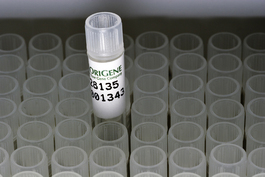Dnmt1 (BC053047) Mouse Tagged ORF Clone
CAT#: MR212057L4
- LentiORF®
Lenti ORF clone of Dnmt1 (mGFP-tagged) - Mouse DNA methyltransferase (cytosine-5) 1 (cDNA clone MGC:62302 IMAGE:5709259)
"BC053047" in other vectors (4)
Interest in protein/lysate? Submit request here!
Product Images

Specifications
| Product Data | |
| Type | Mouse Tagged ORF Clone |
| Tag | mGFP |
| Symbol | Dnmt1 |
| Synonyms | Dnmt, MTase, Dnmt1o |
| Vector | pLenti-C-mGFP-P2A-Puro |
| E. coli Selection | Chloramphenicol (34 ug/mL) |
| Mammalian Cell Selection | Puromycin |
| Sequence Data |
The ORF insert of this clone is exactly the same as(MR212057).
|
| Restriction Sites | SgfI-MluI Cloning Scheme for this gene |
| ACCN | BC053047 |
| ORF Size | 4881 bp |
| OTI Disclaimer | The molecular sequence of this clone aligns with the gene accession number as a point of reference only. However, individual transcript sequences of the same gene can differ through naturally occurring variations (e.g. polymorphisms), each with its own valid existence. This clone is substantially in agreement with the reference, but a complete review of all prevailing variants is recommended prior to use. More info |
| OTI Annotation | This clone was engineered to express the complete ORF with an expression tag. Expression varies depending on the nature of the gene. |
| Reference Data | |
| RefSeq | BC053047.1 |
| RefSeq Size | 5249 |
| RefSeq ORF | 4883 |
| Locus ID | 13433 |
| Gene Summary | This gene encodes a methyltransferase that preferentially methylates cytosines of CpG residues in hemimethylated DNA to generate fully methylated CpG base pairs during DNA replication. This enzyme plays roles in diverse cellular processes including cell cycle regulation, DNA repair, and telomere maintenance. The encoded protein is composed of an N-terminal domain with a nuclear localization sequence and replication fork-targeting domain, a DNA-binding CXXC domain, two bromo-adjacent homology domains, and a C-terminal catalytic domain. Mouse embryonic stem cells mutant for this gene are viable, but when introduced into the germ line, cause a recessive lethal phenotype with mutant embryos displaying stunted growth and developmental defects. Alternative splicing results in multiple transcript variants. [provided by RefSeq, Sep 2015] |
Documents
| Product Manuals |
| FAQs |
| SDS |
Resources
Other Versions
| SKU | Description | Size | Price |
|---|---|---|---|
| MC224567 | Dnmt1 (untagged) - Mouse DNA methyltransferase (cytosine-5) 1 (cDNA clone MGC:62302 IMAGE:5709259), (10ug) |
USD 2,020.00 |
|
| MR212057 | Dnmt1 (Myc-DDK-tagged) - Mouse DNA methyltransferase (cytosine-5) 1 (cDNA clone MGC:62302 IMAGE:5709259) |
USD 980.00 |
|
| MG212057 | Dnmt1 (GFP-tagged) - Mouse DNA methyltransferase (cytosine-5) 1 (cDNA clone MGC:62302 IMAGE:5709259) |
USD 1,080.00 |
|
| MR212057L3 | Lenti ORF clone of Dnmt1 (Myc-DDK-tagged) - Mouse DNA methyltransferase (cytosine-5) 1 (cDNA clone MGC:62302 IMAGE:5709259) |
USD 1,180.00 |
{0} Product Review(s)
Be the first one to submit a review






























































































































































































































































 Germany
Germany
 Japan
Japan
 United Kingdom
United Kingdom
 China
China
